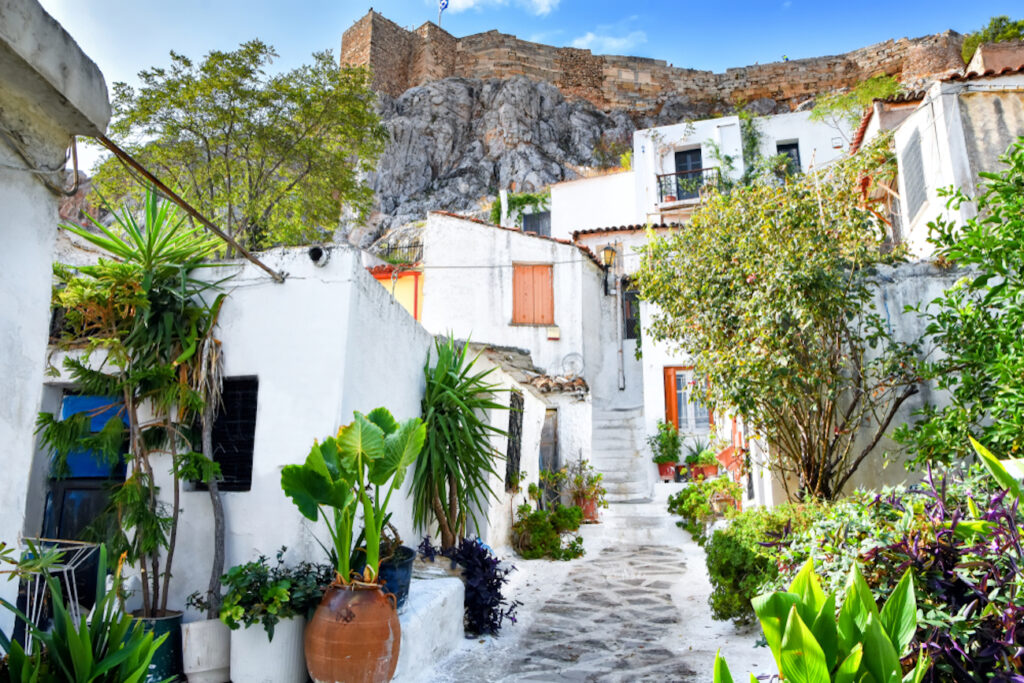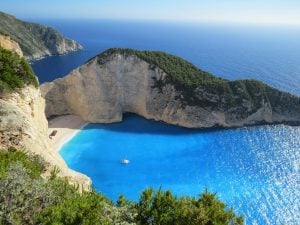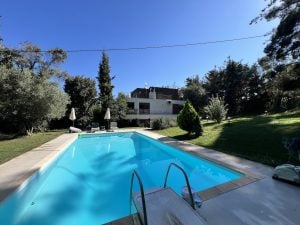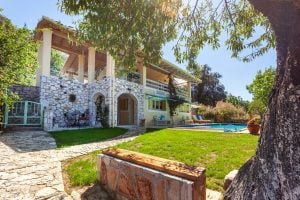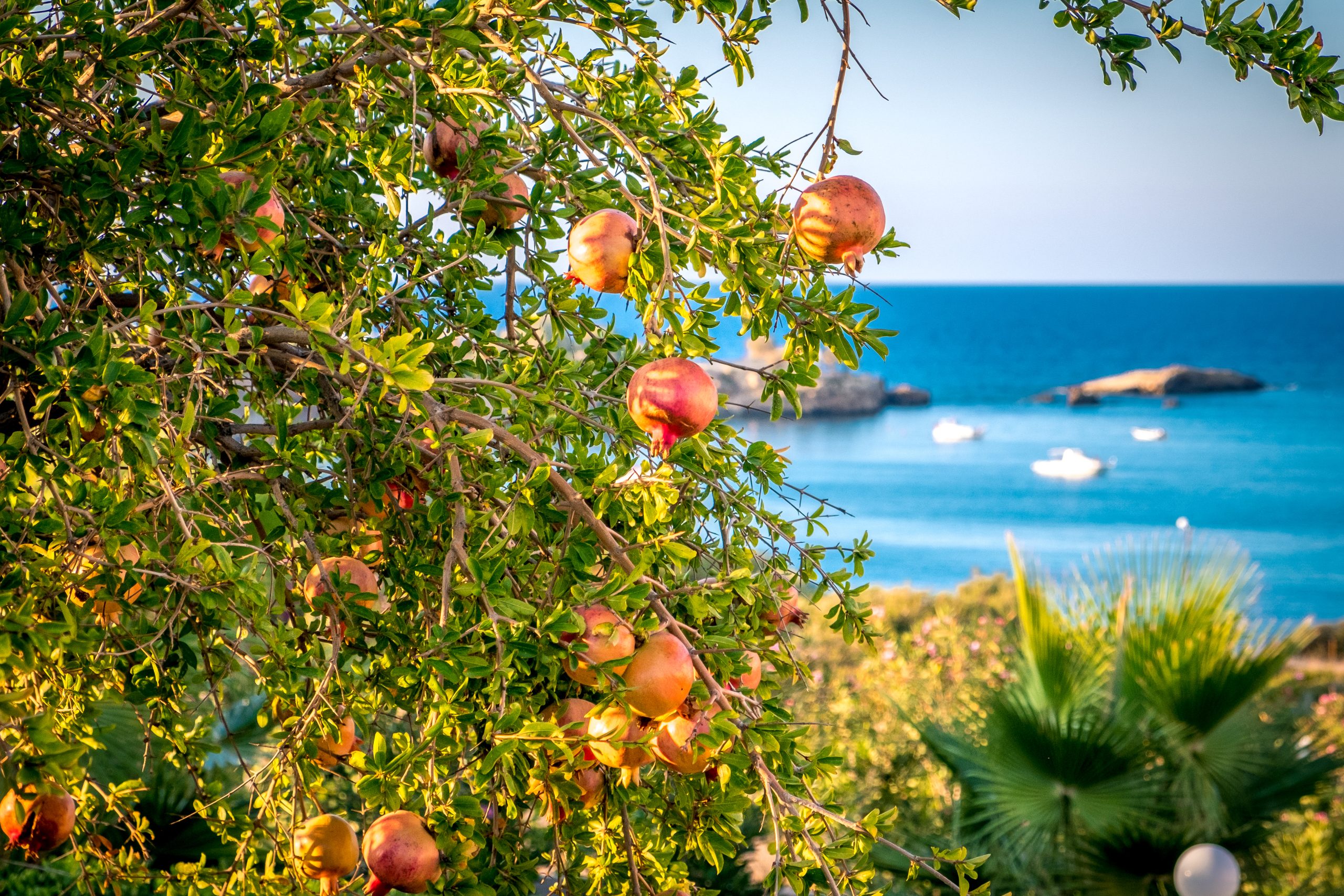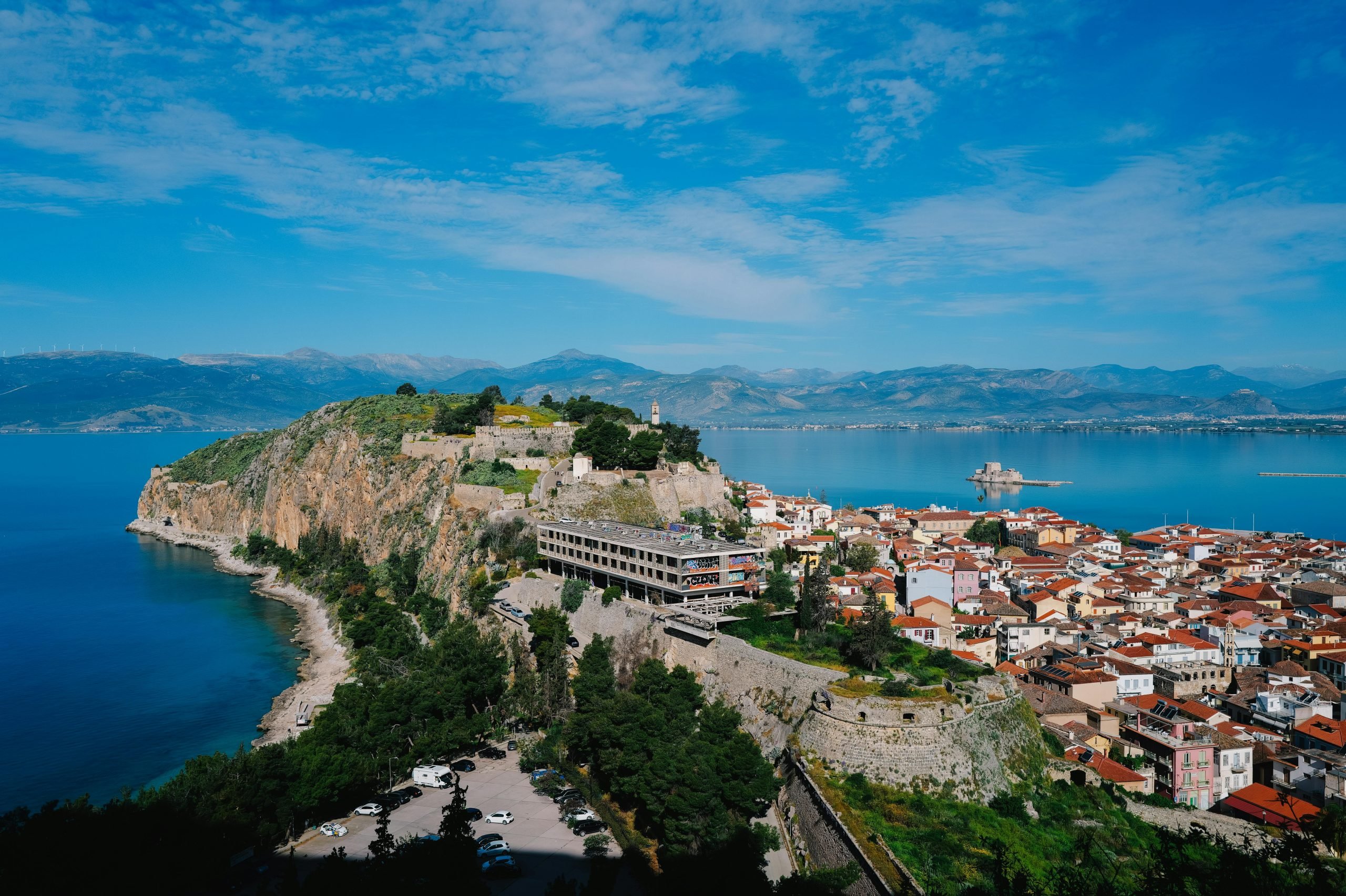Why does Athens look the way it does? What parts of its architecture come from Ancient Greece? Which buildings come from trends in the last 100 years? What are the most recent changes to Athens’ architecture?

Influences from Ancient Greece
Furniture and Decoration
Many homes in Athens today follow the same decoration trends from Ancient Greece. Ancient Greek homes were sparsely furnished. Reeds or straw mats were commonly used to cover floors, and the rooms might contain simple wooden stools, tables, and beds made from grass or animal products like wool or feathers.
While not all these materials are still common, wood and reed products are still a popular choice in Athens.
In Ancient Greece, wealthier families might have had mosaics or paintings to adorn their homes, but generally, the Greeks preferred to showcase their wealth through jewelry, elaborate clothing, and lavish gatherings rather than interior design.
Ancient Greek homes were practical, modest, and often shared spaces where families lived, worked, and carried out their daily routines. Their true beauty lay not in grandeur, but in their adaptability and functionality.
The Home As a Workspace
Is it possible that the “home office” was invented by the Ancient Greeks before computers were created?
Homes in ancient Greece were not just places to live but also spaces to work. Many families had areas reserved for their trade, whether that was weaving, cheese-making, or sandal-repairing. These activities would often take place in the courtyard, on the flat roof, or even within the home itself. Wealthier families might have attached workshops or stores, but for most people, work and life blended together in the same space.
While ancient Greece is renowned for its elaborate temples and impressive public spaces, everyday homes were far more utilitarian. These houses were built to serve the needs of their inhabitants, often with little in the way of luxury or decoration. Despite the humble materials and simple layouts, these homes were the center of Greek family life, reflecting a culture that valued practicality and resourcefulness over opulence within the private sphere.

Roof Ornaments
The akrokeramo (or acroterium in English) is a distinctive, ornamental tile placed at the edges or corners of rooftops, especially on pediments. It serves both a decorative and functional purpose. Traditionally, akrokerama are made of clay or marble, and their front (visible) surface is adorned with embossed motifs, often abstract, such as anthemia (stylized floral patterns).
These decorative tiles were integral to ancient Greek temples, including iconic structures like the Parthenon. Akrokerama adorned buildings throughout the classical era and saw a resurgence during the Neoclassical architectural movement in 19th-century Europe. This architectural feature became a hallmark of the Greek neoclassical style, embraced across social classes, from modest homes to grand urban mansions.
How Were Akrokerama Decorated in Antiquity?
The decorative motifs on akrokerama often reflected natural or mythical themes. Common designs included:
Floral Patterns: Palmettes, lotus flowers, acanthus leaves, and vines.
Protective Imagery: Figures like the Gorgon Medusa, believed to ward off evil.
Color Variations: Designs were painted in alternating black and red, adding vibrancy to their artistic expression.

When Did Akrokerama Experience a Renaissance?
The use of akrokerama dwindled following the collapse of the ancient world. However, the Renaissance and Neoclassicism revitalized interest in these architectural elements. In Greece, this revival coincided with the country’s liberation in the 19th century, bringing European architects who reintroduced the akrokeramo to Greek buildings. Akrokerama adorned royal palaces, churches, public buildings, and private homes, connecting the modern era to Greece’s classical heritage.
Prominent Greek ceramicists, like D. Saris and A. Nastos, collaborated with architects such as Ernst Ziller to craft a wide variety of designs. While not strictly adhering to ancient proportions, these modern akrokerama conveyed a unique charm and sensitivity.
What Happened to Akrokerama in Later Periods?
During the Roman Empire, tile production became more standardized and economical, leading to smaller and simpler roofing elements. In northern Europe, roofing systems adapted to the colder climate, using steeper slopes and introducing new types of tiles, such as “Bieberschwanzziegel” (beaver-tail tiles).
The elaborate designs of akrokerama persisted in some parts of Europe but gradually disappeared, replaced by more utilitarian approaches. However, the 19th-century Neoclassical movement, fueled by archaeological discoveries, rekindled an appreciation for these ancient elements.
The Industrial Revolution introduced mechanized production methods, which revolutionized tile manufacturing. By the mid-19th century, innovations such as high-pressure molding and precise interlocking systems allowed for lighter, stronger tiles. This era also saw the introduction of iconic designs like the “de Marseille” tiles, which remain popular in Greece as “French tiles.”

Influence From the Early 1900s
The Need for Housing
Athens had an urgent need for housing in the early 1900s. The first increase in population came in 1922 with the Greek-Turkish population exchange. 1.5 million refugees left Turkey and were sent to Greece. The population of Athens increased from 200,000 to 500,000 in just a few months.
During the Second World War, Greeks also came into the city from the countryside, where the war was creating poverty. Later, in the 1950s, 500,000 internal migrants moved to Athens, and the population doubled again.
Because of these two periods of migration, Athens desperately needed housing in the capital.
The Solution: Antiparochi
Antiparochi was invented as a way to find housing for Athens’s new residents. Antiparochi translates roughly to “mutual exchange.” Here’s how it works: The landowner gives a plot of building land to a constructor, who builds an apartment block. In exchange, the landowner receives a number of apartments in the completed building. This way, constructors could develop projects without having to invest heavily in purchasing plots.
Today, these buildings are called “polykatoikia.” If you’ve been to Athens, you’re used to the sight — tall, uniform concrete apartment blocks with uniform balconies, extending as far as the eye can see.
According to Panos Dragonas, professor of Architecture at the University of Patras, there was no specific law which said this transaction could happen. The Greek people themselves thought of it. The government, seeing the many benefits, did not regulate the situation. They only added a few restrictions, like a limit on the height of the apartments and a ban on building over archaeological sites.
The Greek government’s idea was to boost construction in order to strengthen the Greek economy. The tax system at the time also favoured new buildings because property transfers (as opposed to new constructions) had a high tax. For contractors, low building costs were ideal because it meant they didn’t need a large loan to start building.

The Benefits of Antiparochi
Because of the antiparochi system, thousands of Greeks were able to find work building, and to send money back to their families in the countryside. Between 1950 and 1977, when the polikatoikia system was popular, the economy grew by 7.7% each year, second only to Japan. This is mainly because of the construction industry.
Some people even say that the antiparochi system ended the civil war in Greece, which was fought from 1946 to 1949. Panos Dragonas, professor of Architecture at the University of Patras, says that “antiparochi turned the polarised society of the 1940s into a wide middle class.” So there was no need for conflict between the rich and poor. Instead of rich districts and lower-class districts, everyone lived together in the same buildings — the polikatoikies.
The Disadvantages of Antiparochi
With such a quick building system, the city was able to grow quickly, but every neighborhood ended up looking the same. Architecture lovers were sad to see that the Neoclassical mansions were replaced by a wall of concrete.

Balconies Everywhere
Athens, unlike most other European cities, maximizes balcony space. Some Greeks use them for items that don’t fit inside, and others deck the space out with furniture. The most visually pleasing balconies are usually full of flowers, potted plants, and climbing clematis. These plants sometimes draw hummingbirds, bees, and other wild birds.
Greeks who spend time in foreign countries miss their Greek balconies, noting that in other cities like Paris, “it’s rare to have a balcony – an almost unattainable luxury.” Walking around Greece’s biggest cities and looking up at the apartment buildings, it’s hard to spot a building without a balcony, even in less desirable areas. Why does this happen in Greece, and not in other European hubs?
Architectural Heritage
Panos Dragonas, a Professor of Architecture and Urban Design at the University of Patras, gives an architectural explanation. Dragonas says: “In the interwar apartment buildings, we see the change from bay windows to small open balconies.” In other words, areas that were once windows became balconies after the war.
Some architects go even further back with their reasoning. George Papadakis from the architectural office Cadu says that architecture in the ancient Greek world always created external covered spaces, like the ancient stoas and the hayiati. In today’s Athens, of course the balcony will still have a central role in the life of its people. “The identity of the modern Greek city is shaped by the aesthetics of the balcony and all of its accessories,” Papadakis says.
The weather in Greece clearly plays a role in the balconies we see. When you compare it to colder climates in the rest of Europe and in the United States, Greeks use their balconies for more days of the year. In other cities, emphasis for building might be on digging deep for foundations (at least 6 feet down to get “beneath the frost.”). So, the focus is on building down, not on building “out.” For this reason, it is common to see cellars or basements in northern european buildings.

Influence From the Greek Islands
Islands are not the only places with white buildings in Greece. Anafiotika is not an island but is a neighborhood in Athens, just under the Acropolis. The district includes whitewashed buildings, windows with characteristic Cycladic-style shutters, and cobbled alleys.
Most of the settlers of the Anafiotika area came in the 1800s from the small Cycladic island of Anafi. Anafiotika literally means “little Anafi” and the builders from this district built houses to mimic their old island homes.
Why White and Blue?
The decision to “paint” houses white was, most of all, practical. Families survived off the land, so it only made sense to build with materials available from the natural landscape. Originally, houses on the islands were built with dark stones. If you take a stroll through the main villages in Mykonos, you’re sure to catch a glimpse of some homes still built with this style.
Stone was the logical building material, being ubiquitous and free. However, being dark, the stones absorbed the light and the interior heated to unbearable temperatures. To cool down their spaces, they painted over the rocks with whitewash – a mixture of lime, salt, and water — which was much cheaper than paint.
Where did the Blue Come From?
Again, frugality reigns. The blue color hearkens from a cleaning agent known as Loulaki (blue powder). It is like talcum powder, and was found in virtually every family home. The name brand also refers to the color pigment “loulaki,” which is akin to indigo. Mixing it with lime creates the bright blue color that we know today on white houses in Greece. This blue was also inexpensive.
